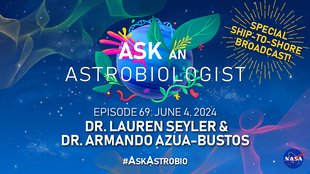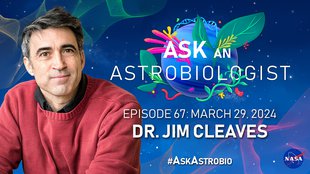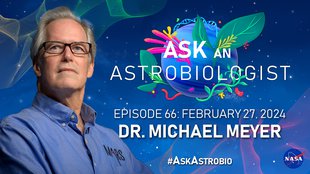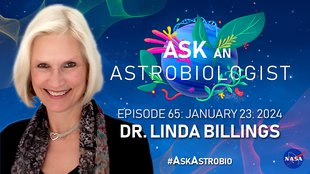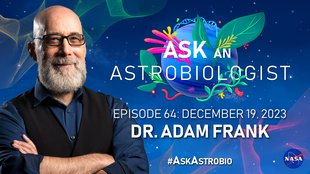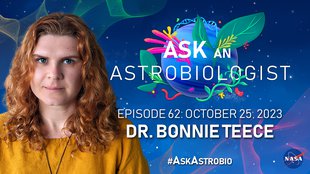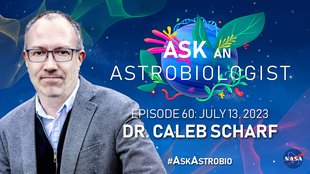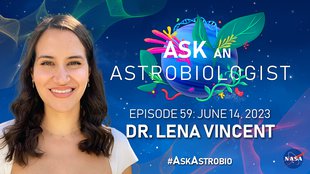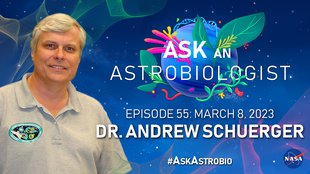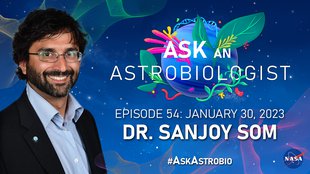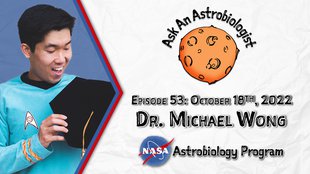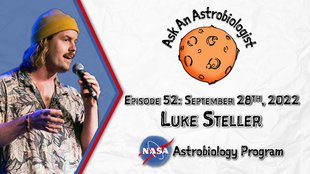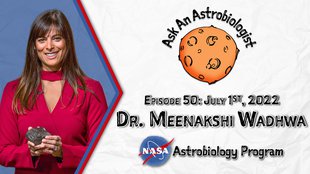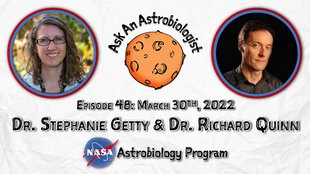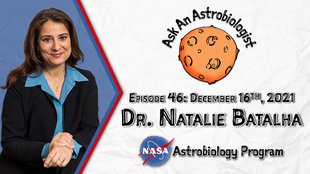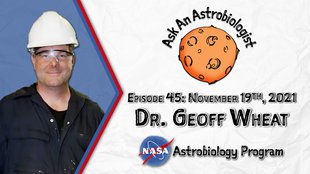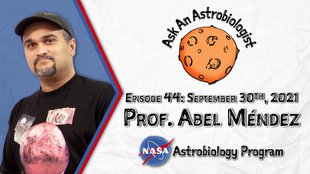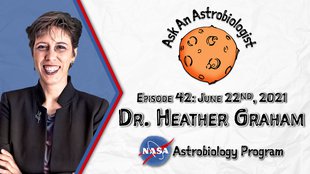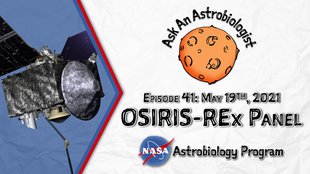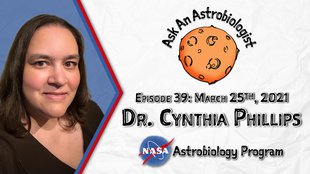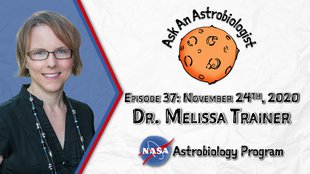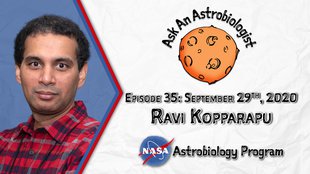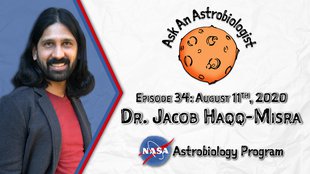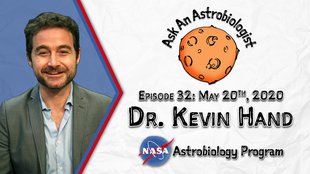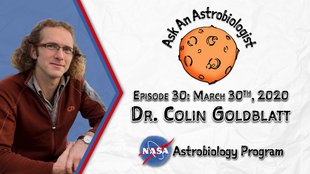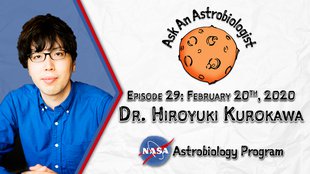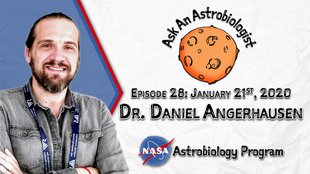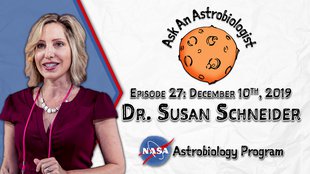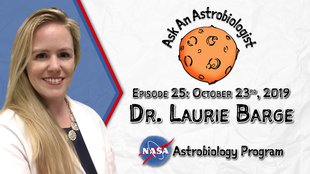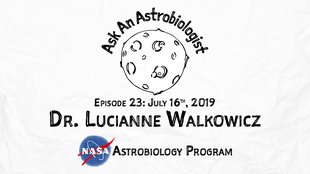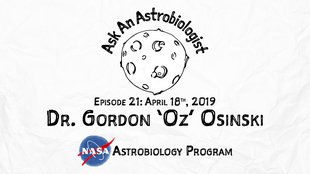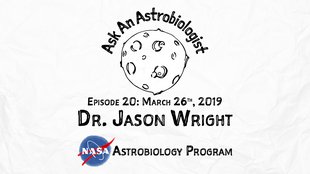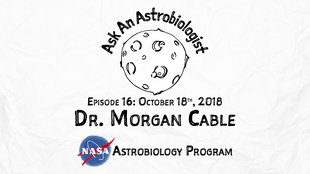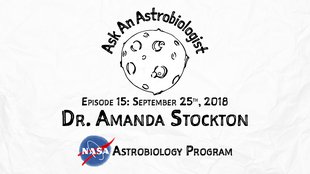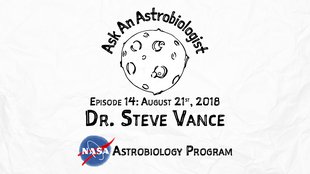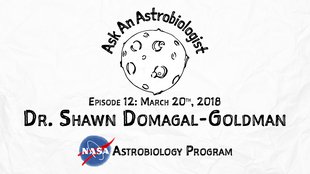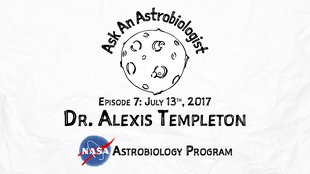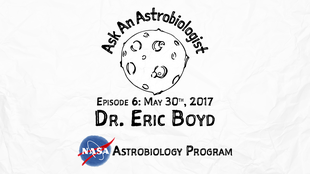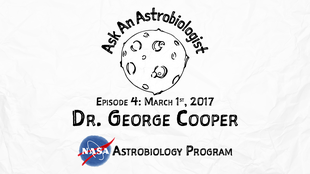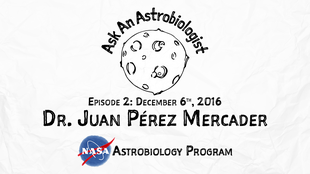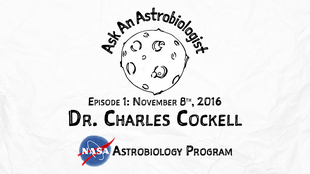
We welcome to SAGANet, Dr. Britney Schmidt, Assistant Professor of Earth and Atmospheric Sciences at Georgia Tech, USA! Dr. Schmidt is an expert in Icy & Ocean Worlds.
You can find out more about her work here.
Greetings, friends of astrobiology. Welcome back to an amazing Ask an Astrobiologist, the monthly interview series of the website SAGANet.org, a show where we celebrate science and celebrate scientists. This show is made possible by contributions from ELSI, the Earth-Life Science Institute at Tokyo Tech, the NASA Astrobiology program and the nonprofit Blue Marble Space.
Other Recent Episodes
Ocean World Science Aboard the Ship 'Falkor Too' with Drs. Lauren Seyler & Armando Azua-Bustos
The Art of How to Become an Astrobiologist with Dr. Aaron Gronstal
How & When Do Molecules Become Life with Dr. Henderson "Jim" Cleaves
My name is Sanjoy Som. I will be speaking very soon to Dr. Britney Schmidt who is an assistant professor of earth and atmospheric sciences at the Georgia Institute of Technology in the United States. But first, it's your monthly background quiz. So Mike, if you could put up the background from last month, which is surprisingly convenient for this month's conversation. You'll notice an icy terrain; we are asking you who could identify what or where this place was. And, the correct answer is Svalbard in the High Arctic. What's amazing about this picture is it's actually an ancient river bed. Of course, Svalbard today is too far north to have water flow, but through the study of the shape of landscapes, we will identify that in fact, the environment was very different, probably around 400 million years ago when that river flowed.
The science of studying the shape of a landscape, we're going to get back to today because Dr. Schmidt recently published a very cool paper in Nature Geoscience discussing the shape of landscape and what that can tell us about the presence of water on Ceres, which is the largest asteroid. So, for next week, what is behind me? It's a wonderful site to study astrobiology. If you know the answer, please use #askastrobio to let us know. And, if you have any questions for Dr. Schmidt during this interview series, please either ask it on the SAGANet.org main chat, or use #askastrobio on Twitter and we'll get your questions answered. So, welcome everybody and Dr. Schmidt thank you so much for being with us today. How are you?
Absolutely. I'm excited to be here. I love doing this fun stuff!
Fantastic. So, before we get to the exciting science, and it's going to be hard to stop for now, but what we like to do in this show is actually turn back the wheels of time a little bit. And if you could share with us, how did young Dr. Schmidt become a scientist?
Well, I would say a proto Dr. Schmidt took a rather circuitous journey to get here. I was always interested in science as a kid, but I also really loved reading and English and a huge fan of music, actually. So, it took me a little while to figure out exactly who I was going to be. When I was an undergrad, I was a little confused on what I wanted to do and so I started off I was an English and Broadcasting major because I actually was really interested in music and sports journalism and trying to do something with that. But I didn't find myself very challenged and I was a little surprised by the university in a lot of ways and so I ended up just taking classes in anything I thought I might be interested in.
One semester I took sociology, I took a chemistry class, I took political science. I took a theater class and I ended up taking this astrobiology class. Well, it basically is astrobiology. It was like the history of the universe and humans and stuff and it sounded really great to me. I had this fantastic professor, it was at the University of Arizona. His name is Dr. Robert Brown. I got really lucky. He was the PI of an instrument. the head scientist on an instrument on Cassini. He brought that into the classroom, the science that was going on and it was really figuring out Europa that I think made me the most excited.
You're talking, of course, of the fantastic moon around Jupiter, and Cassini being the mission that explored Saturn.
Saturn, yeah. Yeah, so when I first heard it in class I was like, "Wait a second. Let me get this straight. We've got an ocean moon that's orbiting Jupiter and we're not spending all of our time doing that?" That's just crazy to me. So it was through Bob's mentorship that helped me find the right classes and really encouraged me to do this because I hadn't thought of it as a career. I was good at science, I just didn't know it was a job and sometimes I feel like it might not be still, but that's more of because it's so fun. So anyway, that's how I got into it and then I got really interested in spacecraft and the way we can use engineering tools to solve science problems and that's really what interests me the most is how do we do that in the solar system and maybe the universe beyond that.
How did astrobiology, in particular, peak your interest?
You know, I think I'd always had these big picture questions about myself. I was always very scientific in thinking but not necessarily surrounded by that. The question of human context had always been really important. For me, it had been something that I'd grown up in a family that was Catholic and it worked beautifully. I have a lot of respect for it, it just didn't work for me. I had always wondered about how we get started, how did the earth form? I was obsessed with the ocean and the sky and trying to figure that out. Science had just always made a lot more sense to me. I think when I got back to that in college and finally took classes that put that in perspective, or at least hinted that that was something tenable in my lifetime was to consider how you get life somewhere or those questions of who we are and where we're going and that's really what it was for me. It resonates on a personal level more even than just the joy of figuring something out that's really interesting.
It's this interesting crossroads between philosophy’s big questions and rigorous science to answer them. I can definitely understand how appealing that is.
It's funny because I think in some ways because I was such a big fan of music and the types of music I like, ironically, is heavy metal and stuff. Actually things are really complex, very mathematical but also have a lot of lyrical content, so that the things that I liked in the written word and poetry and in novels and in music were very similar because they're asking the same kinds of questions and I think representing it differently. I think my particular journey is to take a look at that from a scientific perspective but it's still that same motivation that I think humans really relate to which is that search for information and context for yourself as much as for the things around you.
You mentioned while you were an undergrad you took a bunch of classes in sociology and music and writing. Do these things now permeate into your scientific career?
Yeah, they really do. What I learned was that I didn't want a degree in sociology or in political science, but they were always interests of mine and astrobiology specifically I think really contemplates its role as a language between people, right? How do you contextualize the science that we do? But, I would also say I think a lot about impacts now of some of the other research that we do. I got involved in polar research as a post-doc and have built a little bit of a program to continue doing that. Societal impacts of things like climate change and the evolution of the biosphere and what's happening with that. I think those are themes that I really like and then I've stayed really active in science policy and trying to shape the way at least the United States government funds science and thinks about it. And so that was surprising to me how much impact one person could have on that and strangely enough I would say that just trying to participate in the process even though you don't get everything that you're hoping for all of the time actually gives me a lot of hope because interacting with the people and trying to make things happen. I think you really figure out the people are all pretty earnest for the most part.
It's very easy to polarize people because they don't think the way you do or they don't come from the same background, but I've found that when you work with them to try to accomplish a mutual goal or at least how to understand that maybe your goal isn't central to their motivation, but maybe they could learn why to support it and then you try to help them figure out how to do something that they're interested in. I would say that for me, it's made the political process I think in a lot of ways less frustrating.
It's interesting those interests that I had just as a person, I've been able to keep those in my science career and use the science career to do the things that I really like to do. The nice thing about it is that I get to enjoy the other things just as they are. It's like a side dish. It's kind of fun. The art and music and stuff isn't a key part of what I have to do, so I don't have to be mad about it every day or whatever. It's nice to be able to experience that as well.
Absolutely and I'm glad you mentioned policy. I hope we can continue this conversation down the road in this program. But, I wanted to go back to something you mentioned also while you were an undergraduate is the mentorship you received. Is mentorship something you sought out or was it important to you in advancing your academic career?
I didn't seek it out. I think it was perhaps part of what was missing before I got into science. I just ended up with it. I sought out information because I was so excited about things. What I found was that by conveying my excitement to people they would ask me to participate in things or they'd give me some opportunities and so that's how I've approached now being a faculty member and I have my own PhD students and undergraduate students is I model that interaction off of what worked for me, which is being available but not pressuring people. In terms of mentorship, I don't think I would have known to ask. I wanted information and I got this really great perspective from somebody who cared about me. I think that really did change a lot for me.
It's why I ended up doing this instead of something else. I probably would have loved chasing bands around and managing tours or whatever I was going to do or writing for Spin, but I think having someone who was willing to sit down and say, "Britney, you should do this. You're good at this." I don't think I would have known or had the confidence to keep going, or really even to try it. I just really don't think I would have known that that was an option, even though I was so interested in it. It just seemed like a class you take in school and then you go and you do a real job and having somebody that showed me the other side of it and got me involved in research and was invested in me personally I think is the reason that I'm a scientist today. I try to do that with people as well. That's been true at all stages in my career. I've worked for really, really great people from whom I've learned a lot.
My thesis advisor, Chris Russell at UCLA, was a tremendous mentor. He was a grad student in the Apollo programs so he's quite literally seen it all. Having someone that was excited about the things that I wanted to do myself and would support that was very helpful because it gives you a springboard so you're not having to do everything entirely on your own.
Thanks for returning this mentorship to your students as well. I know you have a lot of students who look up to you in terms of pushing the glass ceiling, I guess, in science. Actually, there's no mystery that's there. There are challenges that exist today and particularly for women to obtain graduate degrees in STEM. Science, technology, engineering and mathematics. I was wondering if you could share some of the perspective that you've had as a woman scientist and things you hoped that you had known when you were going through an academic path or where to find potential solutions in case of issues.
I was very lucky early on. I didn't really see it very much because I had such a great mentor, actually. It's funny, I'll say that one of the things that we often think is that women need female mentors. I think they need to see that women can be successful but they don't necessarily need female mentors. One of the most important things is just to have people that help you have social capital. So when a strange twist of events, it's usually senior male scientists that have that kind of social capital. It's both. I think those are both important. Like I said, I have never ... I had an undergrad advisor at JPL who was a woman who was phenomenal, it was great to have a female mentor and then I've worked as an undergrad and as a grad student and as a post-doc I also worked mostly for male PI's or worked with them. So I think that's part of it. I didn't start to see it as much until I was further along. I definitely had a couple of professors that at the time I just didn't really realize why they didn't like me, and they seemed to like other people a lot more. It was just a little difficult on a personal level, but I don't think I ever really associated it with differences in gender. It's probably what a lot of it was.
I think it's really what is, is there's a lot of buzz words for it like micro-aggressions or little things but a lot of what tends to happens is the things that we use to describe women and men we use different words and one has come to mean leadership and ingenuity and ambition is a good thing and then the other case it can really be viewed negatively that a woman with ambition is somehow negative but I've tried to put blinders on as much as possible.
It's not possible, but I try to at least have a little bit of tunnel vision. One of the things that I've noticed is that I'm kind of a dude, to be honest in a lot of ways. I like sports, I drive sports cars, I like heavy metal. I'm just kind of a little bit atypical. I grew up in competition because I showed horses and stuff. I think in some ways that personality style and those interests made it a little easier for me. I love craft beer so it's easier for me. I like to go out drinking after the meetings and buddy, buddy with people at bars and that's social capital. And for people that aren't like that, whether it's men or women that's a little bit harder. But I've noticed that happens.
The other thing I did definitely notice once, well many examples of it, but there was I remember a female graduate student who I really saw people treat very differently because she dressed very, very girly. Like over the top. But that's what she liked. She liked little skirts with heels and not inappropriate, but just dressed like a woman and she was bouncy and happy. She's brilliant. 4.0 GPA, all that, but they just didn't take her very seriously and it was really hard to watch. It's these little things that you can't ever put your finger on, right?
There's certainly examples of sexual harassment and things like that, that happen far more to women than men in the field. But, I think that things have been really hard to watch are these smaller things. I've tried any number of things. I reach out to other women, mostly, because they will agree with you instead of maybe react with dismay. Every time you tell ... Not all male colleagues obviously, and most of them are amazing, right? But something really bad happened and then often they're like, "Oh, why? That couldn't possibly be." And it's kind of that's really difficult when you're going through it to have somebody react as if you couldn't possibly be right about that. So I think talking to other women often helps. A little bit of blinders and realizing that stuff is hard for everybody, this is the thing that's going to be hard for me.
To have been part of it, just to have an attitude adjustment about it, but the other thing I've tried to do, it sounds totally weird and I try different aspects of this all the time, is I decided I was going to teach all of my classes when I got here in dresses. And because we talk about unconscious bias and whether we see people as experts or as authority figures and I decided that if I have 200 students a year in an undergrad class who might suffer from some of this bias because none of their science teachers were women, were very unlikely to be women, and then if I'm wearing dresses all the time, and I'm also teaching them about the origins of life and the big bang and the evolution of solar systems and grading their exams at least you have that platform of expertise, and I just thought maybe if I do something like that, a. Maybe I soften myself up a little bit, I don't have to always be in a concert t-shirt and jeans or something like that. But I also, maybe I can help that a little bit. I don't know if that's going to have any impact, but it's just one of these things when you're like, "Oh my God, how do I fix this?"
One of the things I decided to try was this bizarre experiment to see if I dressed really super girly if I could help people get over their tendency to think women in dresses were secretaries and not senators or scientists. [crosstalk 00:19:58]
Thank you for sharing your experiences.
I don't know what else to do sometimes, trying things.
Raising awareness and just for the entire scientific community to be just aware of this potentially unconscious bias is important to have. Raising awareness is the first step to changing things. But I want to get to back to ... You mentioned earlier that you did some polar research. That means, I know, you've been to Antarctica. Could you describe a little bit to us that have never been to Antarctica what it is when you get there. What you smell, what you feel like.
That's a really good question. I don't have a very good sense of smell, but actually what I've heard from people is that it's the absence of smells there really because ... And I have noticed that, actually, it's when you're coming back, when you start getting close back to New Zealand. I work with the United States Antarctic Program, so it's always been funded by NASA, but NSF, the National Science Foundation also participates and they run the Antarctic Program. When you go down you take these big military planes from New Zealand because it's pretty close to our station in McMurdo, which is the main station for the US program. The US program has three permanent stations. I guess I can bust out Antarctica. I brought Antarctica with me here. I've got a model of it. It's kind of fun, so the place I was talking about.
McMurdo is in this area. This is an ice shelf, actually, but it's up here. The South Pole is down here and so McMurdo and South Pole are two big stations and then out on the peninsula we've also got Palmer Station. I do most of my work out of McMurdo and it's really neat when you get there because it's like standing on Europa is the way I think about it, right? You land and this environment is entirely white. There's a few little mountains that poke out that are basalts, kind of dark red colored, but almost everything is white and the first time I ever landed there, that was when they still were using the sea ice for a runway early in the season. So, you're landing on a few meters of frozen ocean that's sitting on top of an ocean. It's kind of a trip when you think about it that way.
Even now, we mostly land on the ice shelf. The ice shelf is compacted snow that floats off of the continent and pushes itself together and becomes this sheet of ice. But, that's still only 20 or 30 meters thick in some places or 100 meters towards the front. So, it's kind of crazy that you're landing this giant C-17, these massive military planes on a few meters of ice. That's really a trip. It's beautiful. It's absolutely the most expansive thing that I've ever seen, I think. I think if you remember the first time you looked at a really amazing night sky, maybe you were at the Grand Canyon or out in the middle of nowhere and you turn off all the lights and you're laying in the back of a truck or what have you and that feeling of being swallowed up by something that's absolutely gigantic and when I'm there, that's how I feel. When I think about the night sky, that's how I felt when I was a kid. The first time you ever see the ocean or you're in the ocean and you're battling the waves and you're just at the boundary condition and this huge expansive blue thing is totally in charge here, but it's amazing. Antarctica is like that because it's just so untouched. For all of our trying to understand it and build stations and whatever, it's so minuscule compared to this expansive beauty of the place. It's amazing.
When you turn around and you fly back, is really kind of a funny thing because we've spent a month down there, which I've done a couple times, you're still like it's not that hard. It's like a long work-cation, but not so bad. The last time that I was down, we spent four months there and it's really funny because your brain is normally you've only been gone for four months, but as we get close to the continent, you can start to smell things because it's plants and stuff that you would never notice it just flying in an ocean crossing flight. But, because you've been sensory deprived for a couple of months, you can really feel it. You get there, and you're suddenly overwhelmed by color. You're looking at everything. I remember I pretty much walked straight out into traffic, which is just like I just didn't think about the cars coming, and the whole group of us did it. It was just like, "Oh, there you go, you know, you've made it back from Antarctica and you're going to get smacked into by a car." It's really kind of funny.
It's a really weird experience. Something I really, really like. It's very challenging to be there, but it's an enjoyable experience. I've heard it called Type II fun where it's fun afterwards. It's fun to describe it afterwards and when you look back on it, it's really, really great and when you're in it in the middle you're like, "This is so hard." I like it.
How does working in Antarctica help you better understand icy worlds such as Europa, which is a moon of Jupiter and Enceladus, a moon of Saturn?
I've worked on a couple of different projects and there's a bunch of scientists that do various things down there. The very first thing that I ever worked on, my post-doc advisor is Don Blankenship at the University of Texas. Don's the lead on the radar instrument that's going to fly on Europa Clipper. The radar there is an ice-penetrating radar and on earth, we use ice penetrating radars all the time to map out ... It's almost like taking an x-ray of the ice. Certain wavelengths can actually penetrate through the ice and get scattered back at you based on the structure, so you can look for things like water that's underneath it, they've discovered volcanoes that way that are underneath the ice. Rivers and streams, we can measure the thickness of the ice, we can measure the climate history of the planet at least through the last glaciation, or sorry through the last de-glaciation. So those tools were developed here and what they'll do when we get to Europa is that we'll actually be able to do the same thing except for Europa's ice shell. So, the questions are different but the techniques are very similar.
We're using the same wavelengths to try to find pockets of water in the ice shell, to try to look at how the ridges and geologic features form, to look at impact craters, to try and see I we can actually see the interface between the ocean and the ice shell. So that was the first thing I did was radar stuff, and then I got involved in doing underwater robotics projects. And the reason for that is that the science driver there is that it's just like on other planets, it's very hard to get under the ice in Antarctica. One of the big questions, both for climate research and for planetary research is what happens when you have a huge chunk of ice and an ocean flowing underneath it? If you assume that the ocean is driving the whole system you get a different answer, if you assume the ice is totally passive you get a different answer.
What are their interactions look like and how do you build and melt ice and under what conditions? Those are the same questions, it turns out, that we want to understand for climate science here on earth as what we want to understand for how do we get maybe organisms from the ocean trapped in the ice shell at Europa and then that gets convected up and then we observe it with spectroscopy or with the radars or something like that. What we've been doing is to use our spacecraft backgrounds.
Planetary scientists and astrobiologists, we think about how to do a ton of science in very small amounts of spacecraft, or in this case what we've been doing is trying to build robotic platforms that can get under the ice. I was just going to show this thing right here. This is a 3-D printed version of the inside of the skull of our robot that we built here at Georgia Tech. What this is, is it actually flies through the water like this. There's a CTD, which measured water chemistry up here. We've got a camera and a light source and then a laser pointers down here, and then we have a dissolved oxygen sensor.
What we do is kind of fly around with this long tube-shaped robot. We go through very small holes that we drill through the ice shelf and then we swim around underneath and we take some of the first pictures of the ice environment. Then we map out the ice with sonars and we map out them with imagery. Then, we take water chemistry and oxygen and organic content and all of that stuff so we can understand how biology might work in this environment that's light free and relatively far away from the open ocean.
It's really great earth science, but it's like earth science with a planetary concept in the background. It's how would we do this when we get to Europa? What we want to do is figure out what's living there or if anything's living there. You have to take the right instrument, so we're really asking that question and developing our ability to solve those problems here while we do hopefully really good climate science and really help the earth science community out. It's really fun stuff and that's where the focus is now. How does sea ice form? How do ice shelves interact with the ocean? What can we tell about those systems?
Sounds amazing. We can open up to questions shortly so if you have any questions for Dr. Schmidt, please use #askastrobio on Twitter or post on the signet main chat room. When you receive those pictures, you really feel like you're in another world, right? It's something you're totally not used to. Anything unexpected that you discovered?
I think it's always unexpected. The first time we did this, I called it the walking on the moon picture. It was right when we went through the hole and we saw the ice shelf underneath, and it's funny because you're driving the robots around and trying to figure it out in real time. At some level it's still a little ... It's pretty explorative. We have science questions that drive us, but they're often either not formulated the best or they need some revision, or they're something you didn't really think about. Even though most of what we're doing is oceanography and ice processes and a little bit we're doing more and more on the biology front now, too.
Every time we see a squid or a fish. One of the fun things is the fish there. Some of the fish are actually kind of flat-bottomed and they swim upside down and they attach themselves on the bottom of the ice and it's just a funny thing that you're not used to seeing fish do. To them it's totally normally, but I'm always fascinated by that, which has nothing to do with the science questions we're down there for. You're swimming along these ice mountains that are inverted under the ice shelf and then there's a fish just hanging out attached to the ice. It's really kind of fun.
It's no surprise that new exploration leads to new questions. My last question for you before I open it up is I want to talk quickly about your amazing paper, Nature Geo Science, in which you insinuate based on the shape of landslides on the asteroid series there's water ice there? What are the implications?
Ceres is the largest asteroid in the main belt. It's actually a planet, it's the original downgraded planet. When it was first discovered it was named a planet right where you expect one to be. Ceres is this big, round, and round is important, right? It's about the size of Texas and it's very low density. The hypothesis has been that there would probably be a lot of water ice there. We didn't really know whether it was just going to be a big ball of ice and rock that hadn't mixed up or if it would actually have an ice shelf like Europa and Callisto just covered up with dirt because we can see the ice on the surface, but it was so low density it has all this clay and stuff on the surface that we expected water had to be there in some form or another. When we got there with Dawn, the mission's called Dawn. What Dawn discovered was that it's kind of a mixture of the two. It's got a layer that's relatively ice rich on the outside, and a layer that's less ice rich on the inside. It's never quite created a full ice shelf.
What that means, though, is that it's one of the only places that we've investigated so far in the solar system that has this intimate mixture of ice and rock in the surface. So that means that it does weird stuff. If you imagine just solid rock or soil with no water whatsoever like we see on a lot of asteroids, the weigh that land sides on those things look are kind of flat and maybe cone shaped and material is just falling down a slope. What we noticed on Ceres is that there's a huge number of really distinct landslides. Maybe 20 or 30% of craters, of larger craters actually have these big, massive landslides, which is surprising to have that many. The way they look is really weird. They initially reminded us of things that you see, at least some of them, things that you see near the poles. They also look a lot like stuff that we see on Mars.
What we did is we spent a lot of time looking at the shapes of these landslides and comparing them to shapes of landslides we see on the Earth and Mars. What we really did was measure what's called the deposit or the flow and comparing what the flow looks like and how far it's moved tells you how easily that material is to mobilize. It's a little more mobile than you would expect for dry stuff. The shapes tell this other story. More importantly, there is big, round massive landslides. 100's of meters thick at the toe and they're rolled over. They look a little bit like glaciers, they're not glaciers, but they just have this cohesion that we don't always see in just dry materials falling off a cliff. Landslides that look like that we call Type I. We have Type II where these kind of sheet, dribbly-looking landslides. And then, these other Type III's are associated with these big impact craters. We think those are actually maybe ejecta, or melts that happen.
What it showed us is that there's also a distribution of these with latitude. The big, fat round ones are more towards the poles and the thinner ones are in the mid-latitudes, and then there's a real strong polar trend. All of that tell us is that something is allowing the material to move weird, or weird compared to maybe dry materials, and then it has to have a trend of latitude and the thing that makes the most sense is ice. We've seen other examples of ice on Ceres, but this is a way to look for it in the upper few kilometers for how the material is moving. That's what we did, is look at how they're shape and see what was going on.
That's so cool. I have a million other questions, but it's probably wise to now turning on to our audience. The first question is from Graham. Hi Graham. And he asks, if there is any place on Earth that you could visit to do new research, where would it be and why?
Funny you should mention that, we're in the middle of writing a proposal to do some of this stuff. I love Antarctica. There's one ice shelf that I want to go to more than any other, it's called Amery Ice Shelf. It's closer to the Australian base on the other side of the continent from where we normally work. It's the thickest ice that's in the ocean on earth. It's about three kilometers of ice below sea level, about two and a half to three kilometers. It's very close to Europa pressures and temperatures. That's one of them, but the environment I'm most obsessed with right now is thinking about what are called de-piper salient and oxide basins. They're like salt ponds. They really are salt ponds at the bottom of the ocean.
There are these environments that have tons and tons of salts dissolved in them. You've got the ocean sitting on top of a salty lake, which is kind of crazy. They're actually distinct, so weird organisms, strange ways of adapting to that environment. One of the things that we're interested in is that these may preserve records really well of DNA. One of the concerns we have for the icy satellites is that when we look at Europa we see these dark salts, deposits on the surface and we think there might be water pockets inside the A-shell and one of the things that I've been the most worried about was do we have too low water activity in those environments? Or, otherwise knows as too much salt or something that organisms couldn't live there.
It looks like there's maybe the potential that even if it ends up being bad news for living organisms, that systems like that might preserve DNA really well, or preserve bio-markers. I'm really interested in that. Maybe that's a little far-fetched, but it's one of those systems that I know, or that I want to learn a whole lot more about. That's the thing I've been thinking about the most lately.
How the ice can preserve evidence of extent or extinct life, which is going to be very useful if we ever land on Europa.
I think one of the things we try to do is it is very easy to be like, "Oh, okay, if I want to study a process on a planet, I have to go to exactly that place on Earth." And it's not necessarily true. There isn't any place that's exactly like Europa, so we try to pull apart the pieces of the system. In this case low water activity, hyper salient. In some cases it's no light and relatively cold. It's any of that stuff, so it's just kind of pulling the pieces apart.
Fantastic. Next question is coming from Kai Pieserec who's on SAGANet. Hi Kai. And he asks, how often does marine biology play into your research?
I collaborate with biologists. My background is in physics and in geophysics and more and more learning oceanography. I'm not really a biologist per se. I'm asking questions about energy that's in the environment and then biology takes over from there. I worked with a couple different marine biologists both people that study larger scale animals and people that study microbes and things like that. One of the things we were trying to do in Antarctica is to figure out is there anything living down there. Because every time we put a hole in this ice shelf that's the size of New England, it's very, very remote to the open ocean and to light and to things like that. We see evidence of organisms underneath there and we haven't really tried to understand them very well until now. That's some of the work that we're trying to do in the next couple of years is to understand why are those organisms there. What are they doing and what can that teach us?
Cool, thanks. Next question is if you're given the choice for the next major NASA planetary mission, where would you send your spacecraft? I think you've kind of answered that already.
Europa. Europa. Europa. Yeah, I'm an Europan. I think really there's a lot of ocean world planets that are really very interesting. It's the next frontier. I think Europa is our best chance of having life on it. It's really difficult to get there. It's at Jupiter, five times the distance that the Earth is from the sun so it's pretty far out. The environment's very difficult and it's much bigger than many of the other moons. It's about the size of our moon whereas things like Enceladus are about the size of small asteroids or large asteroids, sorry, not small asteroids. Enceladus is about the size of the state of Arizona, whereas Europa's the size of our moon. So that's just a comparison, but I think what we learned last week there was a great press release about finding hydrogen. Molecular hydrogen in the plumes on Enceladus and so if Enceladus has hydrothermal activity, I certainly assume that Europa does. It's a little harder for that material to make it to the surface, or make it off the surface on Europa because it's so big. But I think both of those places are places we should be exploring.
I'll be honest, my favorite place in the whole solar system is a moon of Neptune called Triton. I really wish we were doing more at Triton. It's my favorite because it's Europa with Triton on top but frozen out. It has a lot of processes, probably a lot like we just saw on Pluto. It's a captured Khyber build object so it's like the craziest thing in the whole solar system. I think I want us to go to Europa because we could ask questions about life on other planets, but if I had to just pick the coolest thing in the solar system to study, I think Triton wins the day.
Triton is so far yet it has nitrogen geysers, which is uncontrolled cool.
The original OG cryo-volcanoes are on Triton.
So with Dawn, you've studied a series and you just published a series. How is it different from Vesta, which was the first target of Dawn or are they different?
Oh yeah, they're pretty different actually. That's one of the reasons that Dawn went to two asteroids. Vesta is like a little volcano all. It's not covered in volcanoes, but it's made in the same material like you would see in Hawaii. It's called basalt. It's not a core and it melted and created a crust and a mantel like a very small version of a terrestrial planet. Vesta's about half the size of Ceres. It just doesn't really have very much water. Then we get to Ceres, which isn't super, super far away in terms of distance from the sun, but Ceres represents a whole other class of objects that were forming with a lot of water in them. And, probably we're hitting the early Earth and those tell us about the inventory of lower temperature thing that were happening in the solar system. In this case, water forming and the chemistry that was going on at that time, kind of pre-biotic chemistry. I think they're ... Even though they're both considered asteroids or proto planets or dwarf planets, they're very, very different.
Fascinating. Keep the questions coming folks. Is the ice that we find in asteroids the source of the water we see on Earth?
That's a question that we have. There's a really cool mission that launched last year called OSIRIS-REx. One of the that things that OSIRIS-REx is doing, it's not directly going to water, but it's going to take actually samples of regolith from an asteroid that is what we call a B-type. We think it would have been one of the asteroids that had water on it. We may actually have samples of material that was processed by water on an asteroid. So we might be able to ask that question. When we look at meteorites what we see is that the deuterium to hydrogen rations might be a little bit better in meteorites, but the water-rich meteorites than for comets. But, one of the things we know is that every object goes through a slightly different evolutionary history and so saying exactly that comets or asteroids or any of that were what brought us all our water is kind of difficult to say.
To be honest, it's probably a mixture of everything is that the Earth certainly formed with some amount of water in it, because it would have created things like Ceres and friends into it. Probably not a lot because it was so close to the sun, but we also know that both comets and asteroids would have been impacting it. It's really kind of a mixture of all that. When we look at the isotopes, there's different isotope systems that you can use to study that. Certain ones say yes, we out-gassed our atmosphere. And certain ones say comets give us this material and others say asteroids are a better fit. We're still disentangling that so I think it's still an open question and a really interesting one.
It's quite fascinating. Water is something we interact with on a daily basis. But still, not quite sure how it ended up on our home planet, so that's another value of studying other planetary systems.
Yeah, absolutely.
You mentioned something that puzzled me, is that you detected presence of clays on Ceres and in my mind clays requires liquid water and transfer processes and Ceres is a cold, dry world. Like liquid water, clays? What's your insights there?
We see lots of evidence for past liquid water, potentially present liquid water deep down. Ceres would have formed early in the solar system, right? Maybe forming within five million years or ten million years of the initial solar system. What that means is that back in the day, Ceres had a lot of what we call short-lived radio isotopes and so those would have been melting water. And allowing that to circulate inside the body. Early on, Ceres probably had some convection that was muddy convection. So, you had liquid water above its melting point but not boiling, probably, but reacting with rocks and processing that material. We see evidence for that. One of the cool things that we see on Ceres are these big impacts that have bright white spots in the middle.
There's evidence that the floors of those craters have melted and probably process created hydrothermal stems and those white spots we think are deposits of different types of carbonates and salts. So, it's the same types of systems that we investigate on Earth that are formed by geothermal heat. But, in this case, the energy from the impact of that itself is probably what's creating at least initially, some of the heat from that. And if there's any squishy or liquid material down in the deep interior of Ceres, and some of the big craters it may be possible for some of that material to come up towards the surface. Whether that's still going on today, at least in terms of interior stuff coming out, it's not clear.
But, there's some evidence for weird cryo-volcanic domes so there's these domes on Ceres that just pop up every once in a while. Not popped up, but they're distributed across the surface randomly. One in particular, and it's very difficult to imagine how that would have formed other than by some type of liquid material or salts or something like that pushing up through the surface and creating these domes. It doesn't have enough heat to have ever melted the rock, so it's not like silicate volcanoes like we have on Earth, so it's this water processes. We think between impacts and it's early history, and some of the energy left over that's really created all these clay materials on the surface. Those play a role in all the weird geology that we see, including the landslides.
Do you think Ceres would make a cool outpost for future humans on their ways to explore the outer solar system?
I guess hopefully you've been watching what's it called? The Expanse? The sci-fi show? They actually kind of played around with that. They have this water outpost on Ceres. Yeah, so it really could be. It's probably the best case we have for relatively shallow water, or water ice in this case. And there's a ton of it by mass. It's maybe about between one and two Earth's oceans worth of water tied up in ice on Ceres. It's kind of a lot there, actually.
That's so cool. My sci-fi mind is kind of going crazy right now.
Yeah, I know. We could totally land there.
What do you feel the next major discover is going to be in astrobiology or in your particular discipline?
Whoo! What's the next one?
That's a question from Graham. Good one.
Yeah, that's a great question. How about what I hope it would be. There's kind of two. I really want someone to be able to figure out the, at least a direct pathway for origins. I think that's really an interesting thing, you know. That would be great, but I'm not sure exactly if it's forming a memory randomly. Is that the step that we're missing, or something like that. That would be super cool. I think the most likely one is I think we're going to see oxygen or something like that in the atmosphere of an exoplanet. That field is moving very, very fast. Sometimes a little haphazardly but it's at least very exciting that we're getting to the point that we could detect atmospheres.
Actually, earlier this week on Monday and Tuesday I was at JPL with a group of folks from Goddard and from the Space Telescope Institute and then a bunch of the universities and I'm on what's called a Science Definition Team for a mission that's being looked at by NASA for the next astrophysics decadal. What this mission is, is it's called LOUVOIR, which is the large UV optical and infrared space telescope. It's basically like Hubble. Like super Hubble. We're studying what you could do with a 15 meter telescope. If you think about it, Hubble is 2.4 meters. The resolving power goes up with your diameter and it's really kind of incredible what you can do with a giant telescope. The fact that we could be with the same telescope watching volcanoes on IO and then taking direct spectroscopy of atmospheres of Earth-size exoplanets around other stars, around sun-like stars.
That just blows my mind, and that's maybe in the next 20 years. Maybe the next 10. The fact that we can get spectra of atmospheres right now, I don't know, it just kind of blows the possibilities open and this n=1 and only one planet or only one solar system that we know very well. Once we go to n=2, or n=5, you know, right now we're detecting the planets, but once we can actually characterize them, oh man. Like that has to be it.
It's a humbling time to be alive, for sure. I think it's going to be almost a religious experience to find possibility of life elsewhere. We're getting really close to time, Britney, but I was wondering if you could perhaps, if you have some advice to offer for up-and-coming scientists who are going to get into astrobiology and perhaps this is a good place to plug-in policy activity.
You know, I think don't discount what you can do I think is the biggest thing, and that works in any field. I think it never occurred to me that I could be a scientist and I didn't know that that was really a pathway that one would want to consider, because it's not ... It just wasn't part of my daily life, at least scientists themselves. I think my advice would be that if you like it, give it a try. Don't say no until you absolutely have to. I think that's the biggest thing. It's very easy to get intimidated by college applications or grad school applications or selecting a place.
If you know who you are and what you want to do, generically you can really find a lot of pathways for that. I think I really benefited from knowing where I wanted to be in 10 years and I didn't say I wanted to be a university professor or any of that. I said I really wanted us to be working on a mission to Europa. That was my definition of success. It allowed me in the foreground to kind of be making changes to what was happening on a daily basis or on a yearly basis, but still allow that to be the long term goal. I think sometimes it gets very frustrating when you put a goal post right here that's very specific, even though the long game is out there. It just makes it seem more of a challenge or more impossible.
When I was a little kid, I absolutely loved 20,000 Leagues Under the Sea. And then I started in spacecraft and now I'm building underwater robots. It's like I've come full circle. I did that by not starting in science right away and figuring out that this is what I like to do. It doesn't have to be about immediately getting everything you wanted or about ... it's often just staying the course and being creative when things that are unexpected happen. We talked about Ceres, and we talked about that. I didn't want to work on that in grad school, but I wanted to be on missions and so nobody was hiring anyone to work on Europa, because when I applied for grad school we had just flown Galileo into Jupiter. So, conventional wisdom at the time was that we wouldn't do anything on Europa until we got a new mission. I've been able to build a career using data that we've had for 20 years just thinking about it differently. It's still possible to do those things and then to build things and get on the next mission and effect the direction that that heads.
You mentioned policy. I think that's actually been a big thing is that even if you don't end up doing science or I think it's important for scientists to be engaged because the real debate I think over science is because people don't know scientists. They think of science as this cold logic hard thing that's very distant and it's telling you what to do. I think that's really unfortunate because I think it's, as we've discussed here, I think it really is telling us who we are and it's the same type of pursuit in that way as religion or as spirituality. It doesn't have to be thought of as this cold, inhuman thing. I'm a human and I'm a scientist.
I talked about not being able to work on the thing I thought I wanted to work on in grad school, or how it's rough being a woman, or any of those things. Those aren't qualities of science, those are qualities of humans and so I think that that's it. I would encourage people to stay engaged. I wish scientists would just be a positive voice and listen as well as they speak about science and then for people to care about science to support it and have those conversations with people. I think we just don't have the conversations a lot of the time. I feel like if we start having conversations openly, then it becomes less taboo or less confusing to people. We have to humanize it a little bit.
Scientists are human as well, believe it or not. Britney, I know you are very busy and I'm so grateful that you took the time to chat with us. It was a wonderful conversation. Thank you again. Great to see you. Good luck on your continued research. For those of you who are watching, next month we'll have a new episode of Ask an Astrobiologist. Next week is the bi-annual Astrobiology Science Conference which is going to be held in Phoenix, Arizona. It will be streamed live on SAGANet, so check that out. It's going to be a fantastic conference. And until then, wishing you all the best and stay curious. Bye for now.
